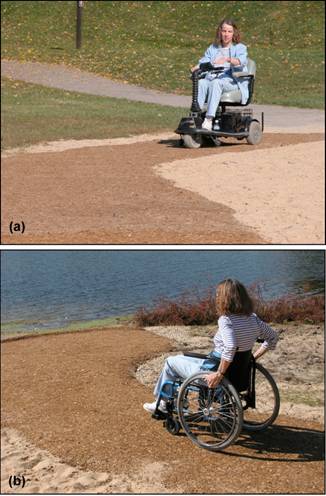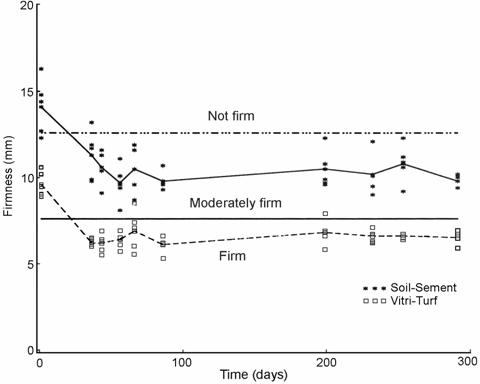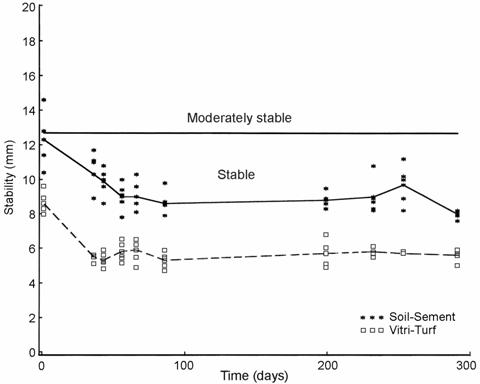Field Observations
A wheelchair user on the beach path described the Vitri-Turf surface as “nice and firm” and the Soil-Sement surface as “kind of soft” (Fig. 12). Maneuvering the chair was noted to be “easy” on the Vitri-Turf and “not as easy” on the Soil-Sement. The user also noted that the raised curb made her feel comfortable about moving to the end of the path. With-out the curb, she felt she would have had to stop a few feet back from the water’s edge.

Figure 12—Testing bonded beach path with (a) battery-powered and (b) hand-powered wheelchairs. Shadow near the waterline indicates terminal curb of beach path.
The bridle paths suffered near total loss of integrity within the first 2 months of installation. Shoed horse hooves broke the thin 50- to 70-mm (2- to 3-in.) surfaces. Material was first broken into dinner-plate-sized pieces and then smaller pieces. The horses did not avoid the SEWF area and were clearly comfortable walking on it. Although a thicker surface would have lasted longer, the clear implication is that eques-trian traffic requires a much tougher surface to resist the forces applied. Because this system failed prematurely due to mechanical loads, it did not remain in place long enough to confirm its ability to control trail erosion.
Impact Attenuation
Impact testing (ASTM F1292, ASTM 1999)) of the Vitri Turf and Soil-Sement surfaces was conducted 8 weeks after installation (Fig. 13).
For the second and third drop tests at 3.05 m (10 ft),
-
average g readings were 223 for Vitri-Turf and
238 for Soil-Sement and -
average HIC readings were 1679 for Vitri-Turf and 1752 for Soil-Sement.
For the second and third drop tests at 1.82 m (6 ft),
-
average g readings were 214 for Vitri-Turf and
196 for Soil-Sement and -
average HIC readings were 1370 for Vitri-Turf and
1214 for Soil-Sement.
Recall that these recreational trails were installed directly on the sand and not on the 0.3 m (12 in) of EWF found at a typical playground site. If the trails were evaluated as play surfaces, both beach path SEWF surfaces would fail the criteria of <200 for g and <1,000 for HIC. When using the 1.82-m (6-ft) fall height (which would be appropriate for people of average height playing volleyball), the Soil-Sement surface was just able to meet the g criteria but failed the HIC. However, given the alternatives available, both surfaces are softer and less likely to cause injury than is
an asphalt path.
Durability
Measures of surface durability are quite subjective unless the loss of durability is a dramatic failure. The curing of Soil-Sement, as evidenced by the stiffening of the SEWF mixture, was slower than that of the Vitri-Turf, and the Soil-Sement surface was “softer” according to one wheelchair user. In the rotational penetrometer test, the Soil-Sement SEWF showed some indication for the top surface particles to detach from the overall top layer faster than did the Vitri-Turf SEWF top particles. The rotational penetrometer readings also reflected changes in stability and firmness of the Soil-Sement surface.
Vitri-Turf SEWF durability with exposure to weather was good and reflected our experience with this material during the past 2 years at the Phase II test site at the Forest Products Laboratory in Madison, Wisconsin. During the spring of 2004 Wisconsin experienced record-setting rainfalls. This caused the level of Cox Hollow Lake in Governer Dodge State Park to rise over 0.3 m (1 ft) for a short period. Park staff reported that the path “floated” off the gravel pad at the path terminus for a distance of approximately 2 m (6-1/2 ft). After the water had subsided, there was no evidence that the path had been lifted and the overall performance of the sur-face seemed comparable to that noted before the high water level.
Accessibility Measures
During the 10-month period of this testing, the firmness and stability of the SEWF surfaces were measured with the rota-tional penetrometer (Fig. 14). Both the Vitri-Turf and Soil-Sement showed good performance for accessibility during this period. The Vitri-Turf SEWF indicated “firm” and “sta-ble” during the entire period, with some fluctuation traceable to the changes in moisture with long rainy spells. Soil-Sement SEWF was rated as “moderately firm” and “stable” during the testing period (Figs. 15 and 16).

Figure 13—Impact testing on beach path was similar to impact test conducted at a playground using a 3.05-m (10-ft) drop-height.

Figure 14—Rotational penetrometer used to measure accessibility.

Figure 15—Firmness of Soil-Sement and Vitri-Turf treatments on beach path over first 10 months of installation.

Figure 16—Stability of Soil-Sement and Vitri-Turf treatments on beach path over
first 10 months of installation.
Costs and Personnel Time for Beach Path Installation
The following summary of costs and time estimates is not meant to be definitive but to document data for the beach path installation.
Quantity of material
- EWF 6 yd3 uncompacted\
- Vitri-Turf 15 gal\
- Soil-Sement 35 gal (45% solids)
| Market value of material for materials used | |
|---|---|
| EWF - $21/yd uncompacted (incl. shipping) | $ 126 |
| Vitri-Turf $18/gal (100% solids, 11 lb/gal) | 270 |
| Soil-Sement $7/gal (45% binder/55% water) | 245 |
| Drainage system (rock, geotextile, and drainage) | 80 |
| $ 721 | |
| Equipment and tool rental (market value) | $ 100 |
| Personal Time | |
| Base prep and geotextile installation, 4 h @ $10/h | $ 40 |
| Bonded surface installation, 16 h @ $15/h | 240 |
Installation of the two surface treatments was completed during one work day. Approximate effort for installation of 200 ft2 of each material (400 ft2 total) was 16 h (4 people for 4 h).
Summary of costs for beach path surface - Cost ($/ft 2 )
| Binder | Labor | Materials | Surface w/labor |
|---|---|---|---|
| Vitri-turf (38 mm, 1.5 in.) | 0.70 | 1.87 | 2.57 |
| Soil-sement (63.5 mm, 2.5 in.) | 0.70 | 1.74 | 2.44 |
Preliminary Guidelines for SEWF Installation
Follow manufacturer’s instructions for storage and handling of the binder. Binder materials must be stored indoors in cool dry storage out of sunlight. Observe recommended limits on binder shelf life. Read material safety data sheets carefully prior to opening containers. Wear protective clothing and eye gear at all times. Assure a period of 48 h of warm and dry weather for proper curing of the binders. EWF should be moderately dry (less than 30% moisture content).
Mixing Binder With EWF
1a. Vitri-Turf binder is mixed with the EWF at the ratio of 77/23 by weight. This equates to approximately 6 liters (1.25 gallons) of Vitri-Turf binder to 0.041 m 3 (1.45 ft 3 ) of EWF (depending upon the density of the EWF
particles).1b. Soil-Sement is mixed 77/23 by weight (assuming 100% solids). If it is only 50% solids then the ratio of weights changes to 63/37. This equates to 10 L (2.5 gallons of Soil-Sement) (50% solids) to 0.041 m 3 (1.45 ft 3 ) of EWF.
2. Mixing is best done with a mechanical drum mixer. If a small patch is needed for repair, use a trough with a hoe. Be sure that the EWF particles are thoroughly coated. Running a typical mortar or cement mixer for 2 min is usually adequate to achieve good mixing. Check the mixer at the end of each mix to assure that binder and fine wood particles are not accumulating on the paddles or drum.
Application of SEWF
- Use a wheelbarrow to transport the SEWF mixture. Dump into place and apply the mixed Binder/EWF at a nominal 50% more (uncompacted) depth than the in-tended compacted thickness using a screed bar or rake.
- Compact and smooth the surface by using a large trowel or stiff plywood (16 mm or 5/8 in.) of dimension 1.2 by 1.2 m (4 by 4 ft) covered with a heavy-mil sheet of poly-ethylene as a release. If material sticks, you may lubricate with kerosene, diesel fuel, or soapy water. Do not saturate surface with these lubricants. After com-paction the thickness will be approximately 40 mm (1.6 in.).
- Apply a moderate downward pressure onto the surface so that the mixture compacts tightly. When using the 4- by 4-ft plywood, a 90-kg (200-lb) person stepping in the four quadrants of the panel should provide adequate compaction.
- Allow to cure in the open air for a minimum of 24 h. Cover only for short periods to protect the surface from direct rainfall.
Cleanup
Clean all tools for Vitri-Turf application immediately with diesel fuel before the surface has dried; use water to clean tools for Soil-Sement application. Once binder has dried it will be difficult to remove from tools, surfaces, or hands.
General Precautions
- Wear protective clothing and eye gear.
- Provide a minimum of 1% slope for all substrates for drainage.
- Ambient air temperature should be 40°F (4°C) or greater and rising when SEWF is applied. Air temperature should remain at 40°F (4°C) or greater for at least 7 days after SEWF application.
- Protect surfaces from rain for a minimum of 48 h
after SEWF application. - Read all material safety data sheets very carefully. If you
do not understand the instructions, contact the manufacturer before applying SEWF. - If binder accidentally comes in contact with eyes, immediately rinse with water and contact a physician.


